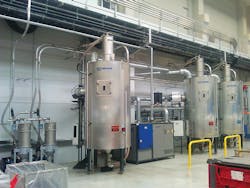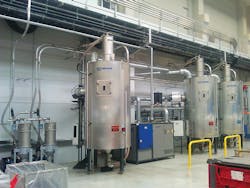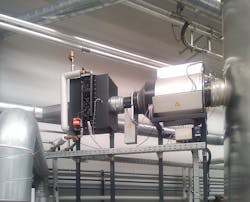Danish firm launches heat-recovery system in N. America
Labotek, a Denmark-based provider of drying, conveying, dosing and mixing systems, is now offering that capability to the North American market with its External Heat Recovery (EHR) system for use with its resin dryers. The company has selected Romax to be its sales and marketing arm in North America.
The EHR system was developed five years ago and has proven to be successful in Europe, according to Lukas Cervonikovas, area sales manager at Labotek.
“This EHR system reduces electricity consumption dramatically,” Cervonikovas said. “A German company called Utz installed the electronic EHR and saved up to 85 percent on its energy costs,” for its resin drying process. Georg Utz GmbH develops, manufactures and distributes reusable plastic packaging for transportation and warehousing. The EHR system was installed in one of its plants in 2017, he said.
The Labotek installation at the Utz facility consists of 12 EHR units that convert excess hot water into hot air and four desiccant flexible dryers. Each dryer has three large drying hoppers — with capacities of 3,000 liters to 4,000 liters — that feed resin to the dryer.
The EHR system includes a heat exchanger, connection to the hot air piping section, connection to the hot water piping system, temperature sensors, hot water piping, a heat-resistant circulation pump and a frequency inverter for the pump.
The drying system is a separate system that can function on its own without the EHR. The main components of the drying system are a Labotek Labo-Net control system to control the drying process, a desiccant flexible dryer that generates hot air and air flow, a drying hopper, vacuum pipes, conveying pipes, vacuum pumps for conveying, filters, material receivers, line clearing valves and a coupling station.
The EHR system is complex and cannot be retrofitted onto an existing resin dryer, he said.
“The drying system, transportation system, dosing systems and the EHR are controlled by a PLC that you need to incorporate the external heat into the transportation system and drying system,” Cervonikovas said. “The cost to retrofit this into an existing system would be much higher than it is to build it as standard equipment in a new system. Retrofitting the software would be expensive.”
Labotek and Romax are working together to offer one-stop shopping for North American plastics processors who are building new plants or adding new production lines to existing plants, he said.
Bruce Adams, senior staff reporter
Contact:
Labotek A/S,
Frederikssund, Denmark, 45-4821-8411, www.labotek.com
Romax Inc.,
Hudson, Mass., 502-327-8555, www.romaxinc.com


